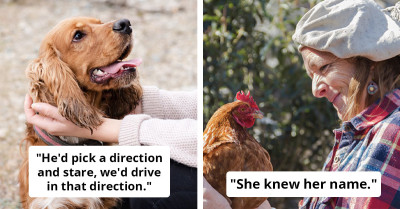25+ Unexpectedly Smart Pets And The Little Things They Learned That Impressed Their Owners
We like to joke that our pets are sometimes smarter than we are. If you have a pet companion at home, I'm sure there has been at least one moment when you saw how intelligent they can be.
It is also true that they chase their own tails and get spooked by their own shadows, so who can really say? But what we can agree on is that they have their moments.
Whether it's actual intelligence or their training kicking in, pets do show some level of cognition from time to time that catches us by surprise. We have all probably seen videos of dogs doing math or read stories about crows retaliating against humans who have mistreated them in the past.
Those videos and stories prove that some animals are smart enough to act on their own will. They sometimes even do things to manipulate us into giving them what they want, like treats and cuddles.
Dogs and cats have also been known to fake an injury or pretend to prolong an existing one because they enjoy the undivided attention their humans give them. Stories like these were the topic of interest in a Reddit forum where pet owners shared the unexpectedly intelligent things they witnessed their pets do.
It's a pretty awesome read that we thought the animal lover inside you would enjoy

1. Dave the cat who protects his human from his night terrors

2. The cattle dog who didn't want to get in trouble

The intelligence displayed by pets, such as the ability of a horse to untie knots, speaks to the concept of observational learning, a key principle in behavioral psychology. According to research in this area, animals can learn not only through direct experience but also by observing others perform tasks, a phenomenon referred to as 'social learning' (Bandura, 1977). This aligns with findings from studies conducted at the University of California, Berkeley, which demonstrate that dogs can learn commands just by watching their owners and other dogs. This suggests that the cognitive capabilities of pets, often underestimated, deserve more attention in understanding their behavior.
Furthermore, the implications of such learning extend beyond mere trick performance; they suggest that pets possess a level of cognitive flexibility that enables them to adapt and thrive in changing environments.
3. The used-to-be-tiny dog who bore the pain because the attention was worth it

4. The labradoodle who could do no wrong

5. You are her charge, and she will herd any of you anytime she wants

The Role of Reinforcement
Pavlov's classical conditioning is a foundational concept in understanding how pets learn behaviors. This theory posits that animals can associate a previously neutral stimulus with a significant stimulus, thereby learning to respond to it. Research published in the Journal of Comparative Psychology highlights that consistent reinforcement, whether positive or negative, plays a crucial role in the training of pets. For instance, dogs that receive treats for specific behaviors are more likely to repeat those actions, as demonstrated by a study from the University of Michigan.
To optimize training outcomes, owners should ensure that reinforcement is immediate and consistent, creating a clear connection between behavior and consequence. This approach can lead to more effective training sessions and a stronger bond between pet and owner.
6. The dynamic duo who will never go hungry

7. The dog who knew exactly what to do to get help

8. The cats who lost their dog buddy and mourned him

The ability of pets to learn and perform complex tasks may also reflect their emotional intelligence, a concept that has gained traction in psychological research. Emotional intelligence refers to the ability to perceive, control, and evaluate emotions, and studies have shown that various animals, including dogs and horses, exhibit traits that suggest a form of this intelligence. According to a review published in the journal Emotion, animals capable of forming strong social bonds demonstrate empathy and emotional responsiveness, which can enhance their learning capabilities.
Understanding this can help pet owners appreciate their companions' emotional needs, leading to more enriched interactions that foster both emotional and cognitive growth.
9. A coonhound who was the master of her territory

She knew when the kids were picked up by an unusual person and alerted her human about it

10. "I know you're tricking me, Brenda," said the cat

Cognitive Bias in Pets
Pets' behavior often reflects cognitive biases similar to those observed in humans. Research from the University of Pennsylvania indicates that animals can exhibit optimism and pessimism based on their prior experiences, which can influence their responses to different situations. For example, a dog that has consistently received positive reinforcement may approach new tasks with a more optimistic outlook, while one that has faced negative outcomes might be more hesitant.
Recognizing these biases can help pet owners tailor their training methods to mitigate fear and build confidence. Owners are encouraged to create a safe and positive environment that fosters exploration and learning, ultimately enhancing their pet's cognitive abilities.
11. The German Shepherd dog who apprehended an intruder

Had a stroll in town, hunted a squirrel, and was home before 5 PM to greet Mom

12. The dog who really wanted to go on a trip

The concept of 'cognitive enrichment' is essential for enhancing pets' learning abilities. Research from the American Psychological Association suggests that mental stimulation can significantly improve animals' cognitive functions and overall well-being. Activities that challenge pets—like puzzle toys or training sessions—can promote problem-solving skills and prevent boredom-related behaviors.
Implementing a routine that includes varied forms of enrichment not only stimulates a pet's mind but also strengthens the bond between pet and owner. Owners should consider introducing new toys, engaging in interactive games, or even varying daily walks to include new environments.
13. The responsible pedestrian

14. There's nothing like waking up because your alarm clock threatened to break your possessions

15. The cat who is concerned about their human's health

Social Learning and Group Dynamics
The social structures of certain pets, particularly in species like dogs and horses, highlight the importance of group dynamics in learning. According to a study published in Animal Cognition, these animals often learn better when they are in a social context compared to solitary learning. This suggests that the presence of other animals can facilitate learning by creating a supportive network where individuals can share knowledge and skills.
For pet owners, this means that interaction with other pets can be beneficial not only for socialization but also for cognitive development. Organizing playdates or group training sessions can enhance a pet's learning experience and reinforce social behaviors.
16. No amount of baby-proofing can stop this cunning cat

17. The dog who pulled himself by his paw straps and got a job

18. Rudi the rat who is living his best life

Owner-pet relationships are central to how pets learn and behave. Research conducted by the University of Cambridge shows that the quality of attachment between pets and their owners can significantly impact their learning experiences. Pets that feel secure and bonded with their owners are more likely to engage in learning and exhibit positive behaviors.
To foster this bond, owners should be mindful of their interactions, ensuring they are consistent, nurturing, and attentive to their pet’s needs. This not only enhances learning but also improves the overall quality of life for both pets and their owners.
19. This hamster who will do no running or standing for that matter

20. This cat who knows that if you want the job done right, you have to do it yourself

21. The Conure who refused to let his human go

Understanding Displacement Behavior
Pets often engage in displacement behaviors, which are actions that serve as coping mechanisms when they are anxious or stressed. Studies in ethology, the science of animal behavior, highlight that these behaviors—such as excessive grooming or tail chasing—can indicate underlying emotional distress. Recognizing these signs is vital for pet owners who wish to improve their pets' emotional well-being.
Psychologists recommend creating a calm environment for pets, especially during stressful situations, such as thunderstorms or fireworks. Providing a safe space and using calming techniques, such as gentle petting or soothing sounds, can help alleviate anxiety and minimize displacement behaviors.
And knew exactly where to perch to evade his snatching

22. The cat with two personas

23. The dog who figured out the most efficient way to get treats

The concept of anthropomorphism, or attributing human characteristics to animals, can significantly influence how we perceive and interact with our pets. While this can enhance our emotional connections, it also risks misinterpreting their behaviors. According to research published in the Journal of Animal Ethics, understanding the actual needs and motivations of pets is crucial for responsible ownership.
Pet owners are encouraged to educate themselves about their pets' species-specific behaviors to avoid misconceptions. This knowledge can lead to more effective training strategies and a deeper understanding of their pets’ emotional and physical needs.
24. I have the gold, give me nutrition

He also knows where to yack his furball

25. I am Sir Cat, I do not frolic

The Impact of Environment on Learning
The environment plays a crucial role in how pets learn and adapt. Research from Stanford University's Department of Psychology emphasizes that a pet’s surroundings can either facilitate or hinder their cognitive development. Environments that are rich in stimuli and offer opportunities for exploration are linked to enhanced learning capabilities.
Creating a stimulating environment involves ensuring that pets have access to various toys, opportunities for social interaction, and safe spaces to explore. Pet owners should look for ways to diversify their pets' environments to keep them engaged and promote continuous learning.
26. The dog who tracked their missing cat so their mom would stop worrying

27. It's a skill he needed for his escape plan

It's pretty amazing to read stories about animals that are unexpectedly intelligent. Science probably says that they can't process emotions and events the way humans do, but based on these anecdotes, we are inclined to believe they are quite intelligent in their own way.
But then again, what do I know? My dog, unlike the ones in this delightful thread, couldn't find his favorite toy if I covered it with a transparent container.
Psychological Analysis
It's fascinating to see how pets often exhibit behaviors that suggest a level of intelligence and emotional awareness. This can be attributed to their ability to learn through observation and social interactions, which highlights the importance of the bond between pets and their owners. When pets feel secure and supported, they're more likely to engage in complex behaviors, reflecting the emotional intelligence that can enrich both their lives and ours.
Analysis generated by AI
Moving Forward: Actionable Steps
Understanding the cognitive and emotional capabilities of pets opens up a new dimension of interaction between humans and their animal companions. The research indicates that these relationships are deeply influenced by social dynamics, environmental factors, and the emotional intelligence of both parties. By fostering secure attachments and providing enriching environments, owners can significantly enhance their pets' learning experiences and overall well-being. Ultimately, a deeper comprehension of animal behavior not only benefits pets but also enriches the human experience, creating a more harmonious coexistence.



